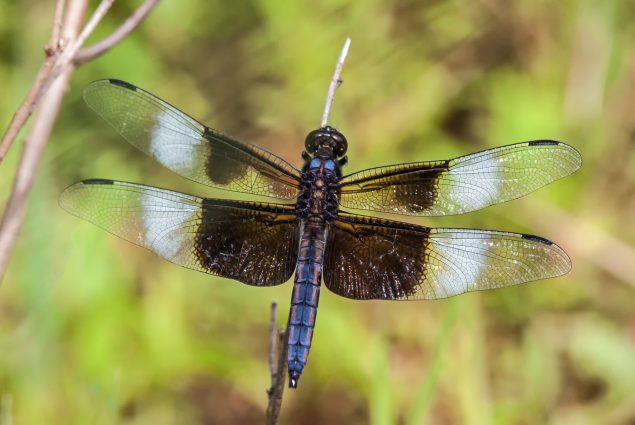Dragonflies are undoubtedly one of nature’s design classics, with a perfectly adapted body plan and behavior repertoire. Dragonflies’ survival depends on the balance of an ecological niche they occupy. Dragonflies are inextricably linked to freshwater ecosystems. The strategies and adaptations that dragonflies employ teach them how to survive in this environment and help them thrive. For most of their life, a dragonfly exists in the form of a nymph. Nymph is a fully aquatic predator that has evolved to take advantage of the abundance of food in freshwater ecosystems. Several dragonflies frequently share the same habitat and have developed a variety of coexistence strategies. There are several species of dragonflies but, for now, we are going to discuss one of the unique species of dragonflies known as the Widow Skimmer.
Widow Skimmer is a large, eye-catching dragonfly that has distinctive tri-patterned flaps. When it is hatched from an egg, the lifecycle of this dragonfly larva known as a nymph begins. This nymph looks like a squat bug. After several years, the Widow Skimmer comes out of this phase and turns into a unique, handsome dragonfly.
Widow Skimmer Dragonfly Male & Female Identification
Widow Skimmer, whose scientific name is Libellula Luctuosa, is a large, attractive dragonfly with distinguishable tri-patterned wings. The bottom layer of the flaps ranges from dark brown to black. There’s a white band after that, and the long-established translucent bar is located at the tip of the wings. The other dragonflies do not exhibit such patterned wings having broad and dark patches on the base. Their abdomen is powdery blue colored, as is much of the top of their thorax. Their face is brown, however; their legs are black. The female Widow Skimmer is lighter in the shade than the male, with brown wingtips and brown patches at the bottom base of the wing. The average size of a Widow Skimmer lies within two inches in length while their wingspan is approximately one and a half inches.
Widow Skimmers are active and strong fliers. You can see the male species frequently squabbling over territories. They vigorously protect their areas against other males and intruders. They keep low to the ground and often fly among the rushes, sedges, and marsh grasses. They fly up to catch prey from perches at the tips of tall grasses and wildflowers. Adults are frequently seen hanging from twigs on plants near the pond’s edge in the evening. Widow Skimmer can eat small-sized and soft-bodied flying insects including, flying ants, sweat bees, mosquitoes, flies, and hoverflies.
Widow Skimmer Dragonfly Male & Female Life-cycle
Widow Skimmers live near warm water. This water source could be a lagoon, pond, marsh, or small lake that is well exposed to sunlight. A skimmer’s early life stage necessitates water, and adults are frequently seen around moist areas as well. Widow Skimmers mate in the vicinity of the ponds. They will form a wheel or a heart shape as they fly together. Unlike other dragonfly species where males guard and take care of their egg-laying females, the Widow Skimmer males leave their females alone by her as she lays her eggs just beneath the water’s surface, thus making her a widow in this whole procedure. When the egg of Widow Skimmer hatches, the lifecycle of the dragonfly larva starts as a nymph. The nymph resembles a small alien or a squat beetle rather than an elegant dragonfly. They live underwater and devour other smaller aquatic insects including, other naiads (larval dragonflies), living in the same pond. The Widow Skimmer requires several years to complete this phase of its lifecycle. They gradually crawl out of the water and onto the land, clinging to a shrub or low plant. They will then molt again and emerge as adults in late spring or summer.
Widow Skimmer Dragonfly Control
Widow Skimmers are not harmful to humans as neither do they bite or sting. Widow Skimmers are very beneficial for us as they can eat all sorts of small annoying flying insects and mosquitoes and can save us from them. The adult Widow Skimmer, which eats insects, has excellent control over the mosquito and flies population. It can consume a large number of mosquitoes and other small-sized insects in one day.



